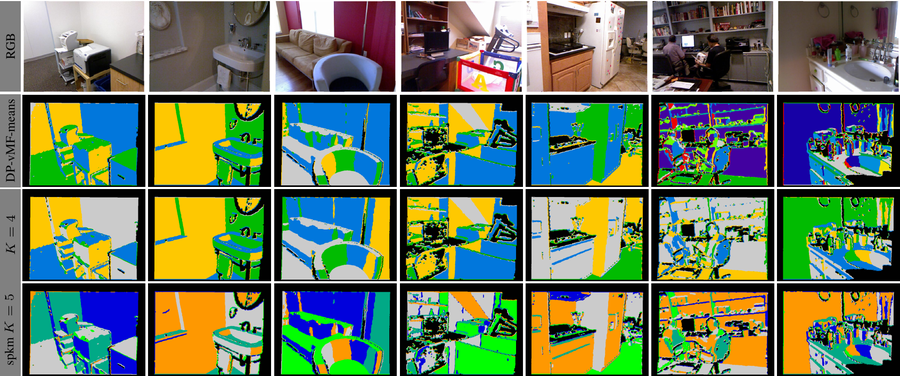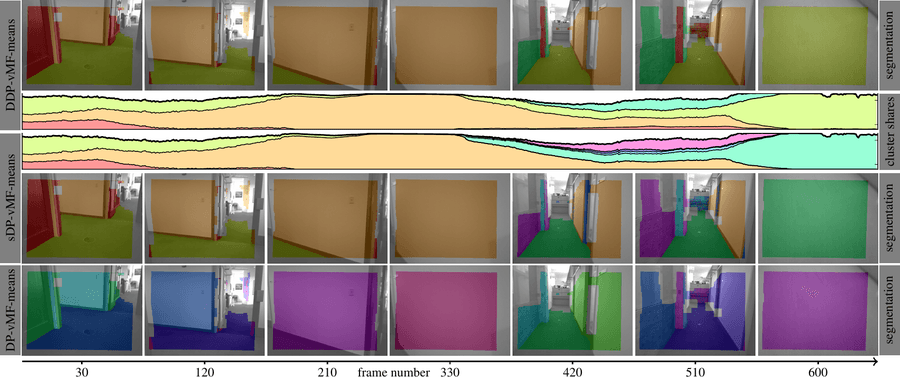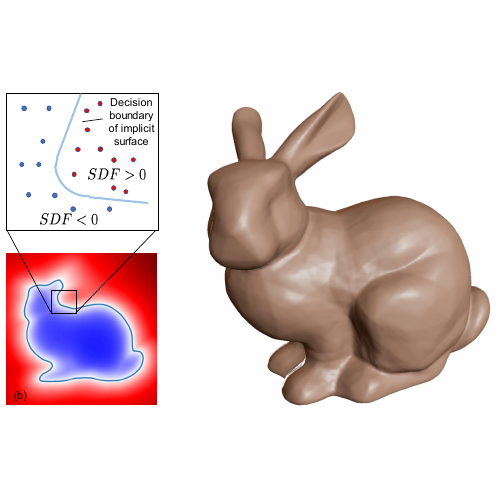Small-Variance Nonparametric Clustering on the Hypersphere
Structural regularities in man-made environments reflect in the distribution of their surface normals. Describing these surface normal distributions is important in many computer vision applications, such as scene understanding, plane segmentation, and regularization of 3D reconstructions. Based on the small-variance limit of Bayesian nonparametric von-Mises-Fisher (vMF) mixture distributions, we propose two new flexible and efficient k-means-like clustering algorithms for directional data such as surface normals. The first, DP-vMF-means, is a batch clustering algorithm derived from the Dirichlet process (DP) vMF mixture. Recognizing the sequential nature of data collection in many applications, we extend this algorithm to DDP-vMF-means, which infers temporally evolving cluster structure from streaming data. Both algorithms naturally respect the geometry of directional data, which lies on the unit sphere. We demonstrate their performance on synthetic directional data and real 3D surface normals from RGB-D sensors. While our experiments focus on 3D data, both algorithms generalize to high dimensional directional data such as protein backbone configurations and semantic word vectors.
Man-made environments and objects exhibit clear structural regularities such as planar or rounded surfaces. These properties are evident on all scales from small objects such as books, to medium-sized scenes like tables, rooms and buildings and even to the organization of whole cities. Such regularities can be captured in the statistics of surface normals that describe the local differential structure of a shape. These statistics contain valuable information that can be used for scene understanding, plane segmentation, or to regularize a 3D reconstruction.
Inference algorithms in fields such as robotics or augmented reality, which would benefit from the use of surface normal statistics, are not generally provided a single batch of data a priori. Instead, they are often provided a stream of data batches from depth cameras. Thus, capturing the surface normal statistics of man-made structures often necessitates the temporal integration of observations from a vast data stream of varying cluster mixtures. Additionally, such applications pose hard constraints on the amount of computational power available, as well as tight timing constraints.
We address these challenges by focusing on flexible Bayesian nonparametric (BNP) Dirichlet process mixture models (DP-MM) which describe the distribution of surface normals in their natural space, the unit sphere in 3D. Taking the small variance asymptotic limit of the DP-MM of von-Mises-Fisher (vMF) distributions, we obtain a fast k-means-like algorithm, which we call DP-vMF-means, to perform nonparametric clustering of data on the unit hypersphere. DP-vMF-means is not much more complicated than spherical k-means as you can see in this basic python-based implementation. Furthermore, we propose a novel dependent DP mixture of vMF distributions to achieve integration of directional data into a temporally consistent streaming model. Small variance asymptotic analysis yields the k-means-like DDP-vMF-means algorithm.
Nonparametric directional clustering of scenes from the NYU dataset with DP-vMF-means

Directional segmentation of scenes from the NYU v2 RGB-D dataset as implied by surface normal clusters. The complexity of the scenes increases from left to right as can be seen from the RGB images. The second row shows the clustering inferred by DP-vMF-Means while the third and fourth show the spherical k-means results. Black denotes missing data due to sensor limitations. Note that DP-vMF-means adapts the number of clusters to the complexity of the scene.
Temporally consistent directional clustering with DDP-vMF-means

Clustering of a surface normal stream recorded when walking a 90 degree turn in an office environment (see video above as well). We depict key-frames color-coded with the implied surface-normal clustering for three clustering algorithms. The plots in the second and third row depict the percentage of normals associated to the respective cluster for DDP-vMF-means and sequential DP-vMF-means. Note that only the clustering obtained via the DDP-vMF-means algorithm is consistent across the whole run.
Bibtex
@inproceedings{ straub2015ddpvmf,
author = {Straub, Julian and Campbell, Trevor and How, Jonathan P. and Fisher III, John W.},
title = {Small-Variance Nonparametric Clustering on the Hypersphere},
year = {2015},
booktitle = {CVPR},
url = { http://people.csail.mit.edu/jstraub/download/straub2015ddpvmf.pdf}
}


